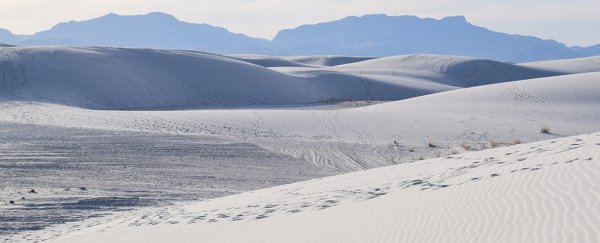Spread across the White Sands National Monument in New Mexico lie the 'ghost tracks' of long-dead mammoths. Now, researchers using a special type of scan have revealed other footprints; they belong to ancient humans walking deliberately inside mammoth tracks.
It's a fascinating glimpse into life some 12,000 years ago at the end of the Pleistocene era, and it's made possible through the use of ground-penetrating radar (GPR) scans, which are able to peer beneath the surface of the ground to reveal the hidden contours underneath.
GPR isn't a new technology – it's used to check for cracks in railway lines, and in geology and archaeology – but it hasn't been deployed in this way on fossilised footprints before. It promises to give scientists access to a host of tracks and prints that aren't visible to the naked eye.
 Researchers at work on the White Sands. (Cornell University)
Researchers at work on the White Sands. (Cornell University)
These hidden records can tell us much more than just who (or what) walked where: a footprint can reveal the size and gait of animals, the way that humans and megafauna interacted with each other, and more detail about life in the last Ice Age.
"We never thought to look under footprints," says research scientist Thomas Urban, from Cornell University.
"But it turns out that the sediment itself has a memory that records the effects of the animal's weight and momentum in a beautiful way. It gives us a way to understand the biomechanics of extinct fauna that we never had before."
Part of the beauty of the GPR technique is that it can scan below the surface without the need for excavation – the equipment simply needs to be dragged across the ground to take measurements. It's the equivalent of getting long-extinct animals into the lab to step on a pressure plate.
Records like this are exceedingly rare, which makes these findings even more exciting. Among the tracks discovered are 800 metres (2,625 feet) of human footprints, crossed with prints from a large proboscidean – maybe a Columbian mammoth (Mammuthus columbi). It looks as though the mammoths were stalked for food or fur.
The findings match up with analysis carried out last year by the same team. In this case however, much more detail and depth has been revealed – more clues about the underlying sediment, which can reveal how the ancient creatures were walking.
"But there are bigger implications than just this case study," says Urban. "The technique could possibly be applied to many other fossilised footprint sites around the world, potentially including those of dinosaurs.
"We have already successfully tested the method more broadly at multiple locations within White Sands."
With GPR available, researchers don't have to wait for the perfect conditions to be able to spot and analyse footprints, something that's particularly useful in the shifting landscapes of the White Sands, but can be invaluable elsewhere too.
While campsites and kill sites offer up a lot of useful info for palaeontologists, knowing what humans and other animals did outside of these areas is more difficult to figure out. Study techniques like the ones used here could help with that.
The mammoths and giant sloths that once roamed this part of the world aren't coming back, but the footprints they left behind can help us piece together details of how they moved around – and how humans followed them.
"Even though we may never find the fossilised remains of the animal that specifically made those tracks, we know how it moved, how large it was, how fast it was going, and what it was associated with just by looking at the tracks," palaeontologist Lisa Buckley, who wasn't involved in the study, told Jeanne Timmons at Gizmodo.
"One animal will only ever leave one skeleton, but it has the potential to leave countless tracks in its lifetime."
The research has been published in Scientific Reports.
